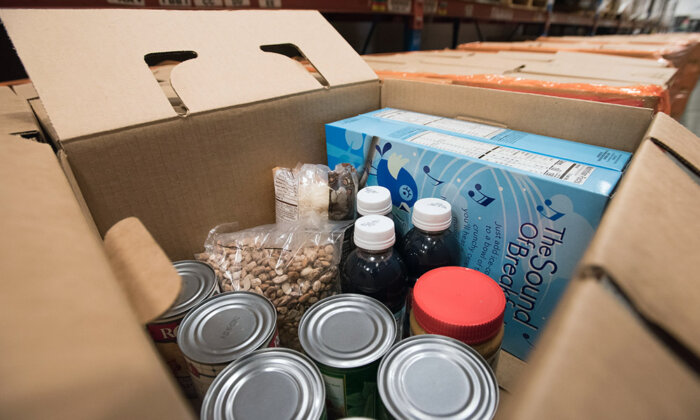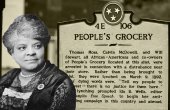The Stigma of Poverty: In Conversation With Rebecca de Souza

Some critics have described neoliberalism as “capitalism with the gloves off,” a model that promotes the aggressive expansion of business forces without the mitigating balance of nonmarket and democratic forces. Neoliberal stigma, then, a term scholar Rebecca de Souza employs in the subtitle of her book “Feeding the Other,” refers to a particular kind of Western and American narrative that focuses on individualism, hard work, and personal responsibility as defining attributes of human dignity and citizenship. “When people do not live up to these parameters, for reasons out of their control,” she writes, “they are marked as irresponsible, unworthy, and ‘bad citizens,’ creating the ‘Us and Them’ phenomenon.”

Perhaps nowhere is this more apparent than across food pantries in the United States, a country that has one of the highest rates of hunger and food insecurity in the industrialized world, with poor households, single parents, and communities of color disproportionately affected. Stigmatizing narratives about those who are hungry and food insecure — that is, poor people, women, and racial minorities — only serve to uphold and legitimize the unjust food system, argues de Souza.
We asked de Souza, whose book is freely available for download via open access, about the sources of this stigma and what can be done to disrupt it; why some recipients receive harsher scrutiny in the food system than others; and how free and reduced school lunch programs could be better executed. Our email exchange has been condensed for space and clarity.
The Editors: Why, as a society, do we feel the need to control how poor people use their government assistance aid?
Rebecca de Souza: The need to control the poor and assistance to the poor stems from two deep and interlocking ideas: First, the myth that poor people are lazy, morally defective, irresponsible, and cannot be trusted with decision-making, and second, the idea that the rich have the right to discipline, control, and punish the poor and people lower down on the social hierarchy. The former belief is used to justify the latter — and concerns over public safety, public tax dollars, and national economic interests are also thrown into the mix to justify control over the poor.
This idea that poor people are lazy and irresponsible is an inherited one and requires some historical learning (Chaim Waxman’s book “The Stigma of Poverty” is a good place to start). Briefly, this myth emerged in the 1300s in England and was then codified in the English Poor Laws of the 1800s. A variety of ideas floating around at the time contributed to this myth including Calvinism, a Christian sect that saw work and economic success as a sign of God’s blessing. A milder form of this is propagated today via the gospel of prosperity with some unintentional consequences. The doctrine of social Darwinism and the “survival of the fittest” also reinforced negative attitudes towards the poor and disdain for public assistance. Interestingly, The Poor Law Amendment Act of 1834 stipulated that “paupers” could not get public assistance unless they went to live in special workhouses — one of the first of many drastic measures taken to control and punish the poor.
The distinction between “deserving and undeserving poor” is a false dichotomy. There is no such thing. All people are deserving of assistance.
Fast forward 200 odd years and you see the same basic idea codified in the United States in The Personal Responsibility and Work Opportunity Reconciliation Act of 1996 (PRWORA), also known as the Welfare Reform Act. The PRWORA is what we might call a workfarist policy, which extracts work or “seeking work” from people in order for them to receive assistance including SNAP benefits.
And here too the link between past and present ideologies is absolutely striking. The English Poor Laws of the 1800s, in order to make a separation between “deserving and undeserving poor,” identified four categories of people: the aged and really impotent, children, able-bodied females, and able-bodied males. The last two categories were seen as “undeserving” because of the assumption that these were folks who were able to work, but just did not want to. Today in the United States, able-bodied men and women without dependents are still central to welfare discussions and SNAP in particular, and are constant targets of disciplinary measures and policing.
So you might say that this sounds reasonable: If people can work, then why do they need assistance? But the notion of “able-bodied” does not easily account for the millions of Americans who suffer from addiction, mental illness, and have illnesses that are invisible. And of course the big elephant in the room that is conveniently forgotten is the lack of decent jobs, an economy that does not match the available labor market, and high unemployment.
The Editors: As of March 2019, 15 states have approved measures allowing them to test welfare recipients for drug use and revoking aid from people who test positive. This is a clear demonstration of neoliberal stigma at work in the distinction between the “deserving and undeserving poor” which, as you discuss, is informed largely by Calvinist thinking. What is the history behind this line of thought?
RdS: So, I should first state that the distinction between “deserving and undeserving poor” is a false dichotomy. There is no such thing. All people are deserving of assistance. Low- and no-income people are especially deserving of assistance because poverty denies people access to fundamental needs and human rights such as food, clothing, shelter, healthy environments, health care, and access to quality education. Poverty also denies people access to opportunities, experiences, positive social interactions, and valued identities.
When we talk about measures and practices put in place to separate the “deserving and undeserving poor,” we should recognize that these measures are based on a much more severe, harsh, and fundamental idea that the poor should be controlled and punished for being poor. Drug testing of welfare recipients is just another way of controlling the poor.
Drug testing of welfare recipients is just another way of controlling the poor.
We need to be clear that people are being scrutinized and punished for being poor — not because they are using drugs and not because they are using public tax dollars, although this is often the reason given for such measures. If this were the case, then we would see a similar pattern of disciplining for rich and middle-class folks who use drugs and public tax dollars, but we don’t. For instance, I could very easily use drugs and still claim my tax credits each year, and no one is going to ask me to take a drug test to ensure that I am clean and that I use my tax rebate responsibly. In a neoliberal era, wealth humanizes individuals while poverty dehumanizes people and therefore legitimates this kind of invasive policing. This is an idea rooted in the medieval era, codified in the English Poor Laws in the 1800s, and then transported to America.
This conditional access to welfare benefits makes a mockery not just of poverty, but also addiction. Today we know that drug addiction is a health concern that is rooted deeply in biography, history, and even brain chemistry — our own public health research and evidence-based medicine tell us this. Yet, we continue to use a medieval lens to view the issue of addiction and poverty. Such disciplinary measures are misguided at a most basic level because they fail to consider Maslow’s basic hierarchy of needs — people must have their basic needs met, before anything else can be asked or expected of them. Instead, the PRWORA asks for work and for one to be drug-free in exchange provides food and other benefits. This is contrary to the human rights agenda and the food first principle, which says food first, after that we can talk about other things.
The Editors: You interviewed a number of people for your book, one of them a woman named Trinity. You explain that when she buys “bad food,” she is chastised for not taking care of her health, but if she buys “good food,” society is suspicious of her for purchasing luxuries with public tax dollars, calling her a “welfare queen.” Why do black female recipients fall under harsher scrutiny in the food system?
RdS: Black women fall under harsher scrutiny not just in the food system, but in every system. This happens because of everyday racism. However, we have to start thinking about racism not as the final answer to the question, but as the beginning of another set of more significant questions such as: Who benefits materially, politically, and socially when Trinity is caught between these two tropes? Who benefits when Trinity moves more cautiously in the world censoring her every word and action? Who benefits when Trinity is “caught” for allegedly defrauding a system?
First off, let’s be clear, racism is the fundamental belief that white people are superior to Black people and people of color. The superiority attributed to whites cuts across a variety of arenas — morality, health, skill and ability, intellect, work ethic, etc. The end result of racist ideology is the material, social, and political disenfranchisement of people of color, something we term structural racism today. While structural racism disenfranchises people of color, it simultaneously leads to the material, social, and political advancement of whites — this is a very important point that starts to reveal what lies beneath the text of racism.
Reagan regaled his audiences with stories of women who were defrauding the welfare system and living the high life, fostering the false belief that welfare fraud was a nationwide epidemic.
The story/stories of the “black welfare queen” is a good case study to explore who wins and who loses in a racialized system. Historically, the black welfare queen trope can be traced to discourses used by Reagan in his campaign rallies in 1976 and during his presidency. Reagan regaled his audiences with stories of women who were defrauding the welfare system and living the high life. In one particular speech, Reagan told the story of the “Cadillac-driving Chicago welfare queen,” who had “eighty names, thirty addresses, twelve social security cards” and was collecting veteran’s benefits on four nonexistent deceased husbands. In his depictions, the welfare queen was a con artist, lazy, and black — and unashamed of taking money from hardworking citizens. The queen, Linda Taylor, may have existed but as Josh Levin points out in an article at Slate, by propping her up as a villain, “Reagan marked millions of America’s poorest people as potential scoundrels, and fostered the belief that welfare fraud was a nationwide epidemic that needed to be stamped out.” In fact, SNAP fraud rates are lower than any other government program, and this story which Reagan told the year before I was born is still alive and well today in food pantry spaces and the public sphere.
The Editors: In the 1980s, Ronald Reagan cut federal school lunch budgets by a billion dollars and proposed that ketchup is a vegetable in order to meet nutritional standards — a precursor to the “pizza is a vegetable” debate of 2011. How do free and reduced lunch programs reflect the neoliberal stigma evident in food pantries? In what ways could they be better executed?
RdS: Fifteen years ago Marion Nestle warned us about why we need to be wary of the USDA’s dietary guidelines, and the “pizza is a vegetable” debate is a fine example of this. There is a major conflict of interest created by the USDA’s dual mandate to protect agricultural interests and advise the public about healthy diets. The USDA subsidizes and provides price supports for sugar, corn, and milk and other commodity foods each of which are supported by strong lobbies, so how can we expect sound dietary advice from these quarters? The National School Lunch Program (NSLP) falls into this same category of a program that suffers a conflict of interest. The program is meant to help families cope with hunger and food insecurity through the school year — and it does, but this is just one of the reasons the program exists. The program is set up primarily as a means to subsidize the industrial food system. With regards to food, sending cheaper foods to schools via the NSLP pipeline means less funding for that program and the power to cut funding for the program — and of course this cheap food is easily available.
Is there a better way to execute NSLP? Yes, first we need to make sure that schools are funded adequately for the program — not just to provide cheap processed food, but to provide good food. I am troubled by how food access for the hungry on the one hand and support for agriculture on the other hand are always in the same frame. They are brought together in the Farm Bill, where support for rural agriculture and support for urban hunger are tied together such that one does not happen without the other. Food scholars note that there would be no support for the hungry, without support for agriculture, and this also tells us something about the country we live in. The result is an incredible burden for schools to forge relationships with local farmers and for farmers to be able to set up these distribution networks. So many schools that do not have access to these resources still continue to serve cheap processed food.
We live in incredibly mean times, so food pantries that pay attention to how they represent the poor at a time when the poor are being violently surveilled, scrutinized, and vilified in the public sphere are on the right track.
Another way in which the program could be run better is to ensure that distinctions are not made between kids. There are schools in which children experience direct stigma because of participating in NSLP — the same kinds of stigma that their parents who use SNAP benefits face. These schools actively stigmatize children. Children are asked to stand in different lines, served food from a different line, given food in a brown bag — here the bodies of children are used to fight political ideological projects. These schools must be penalized and state and federal governments should step in to hold them legally accountable. Children (rich and poor kids) are incredibly attuned and sensitive to distinctions made amongst them. Stigma impacts how kids live, move, and play in the world, just as it does with adults.
In addition to increased funding for NSLP, there are changes that schools could make to bring about transformative shifts in culture and worldviews. School lunchtime can provide a tremendous opportunity for learning (and relearning) what it means to be human — part of that is finding joy in food and the ceremonies associated with food. Lunchtime could be the center point and high point of the school day. There could be tablecloths on the tables and freshly cooked food with color and variety. To do this, there would be funding to hire full-time cooks and food mangers to procure and prepare fresh food for children, teachers, and staff each day. This would be a time when all work stopped and people came together to eat. Mealtime would be longer than ten minutes. There would be less care and attention given to the caloric content of the food and its biochemical components and more to how it is prepared, who prepares it, and how kids eat together as equals — and equally, and how kids clean up after themselves. I don’t think it is that farfetched an idea. In fact it is quite basic. Of course, this would mean a fundamental redesign of how the government funds NSLP and the school day itself, but that’s the kind of transformation that we need across the country. And politically, who could be against that?
The Editors: You argue that food pantries can help disrupt the stigma around the poor and hungry despite being at the “the bottom of the [food system] pecking order.” How are food pantries acting as centers of transformation and influencing food justice?
RdS: Food pantries that amplify the voices of the hungry and food insecure are already doing something transformative. We live in incredibly mean times, so food pantries that pay attention to how they represent the poor at a time when the poor are being violently surveilled, scrutinized, and vilified in the public sphere are on the right track. Food pantries that recognize their place in the food system and understand how they reinforce racial and class-based hierarchies are doing important work. Transformation happens when food pantries account for the trauma, the pain, the abuse, the grief, and the aspirations that people carry with them; when they are able to be explicit in expressing and articulating racial injustices, historical and contemporary; when they recognize how hectic, stressful, and anxiety-ridden poverty is and make a “preferential option” for the poor; when they are explicit in letting people know that it is not their fault and recognize the value, the history, the richness of who is in front of them; when they invite people who have experienced hunger to serve on their boards; when they engage volunteers and clients in political processes to advocate for the hungry and food insecure; when they allow people to interact with each other and bring people together not as volunteers and recipients, but as people who must all learn something about power. In fact, food pantries that find ways to get rid of their volunteer programs and offer up paid positions to community members do this work — that would be a step in the right direction. This would involve training and leadership development and providing other inputs to support their work
In the book, I write about an organization called Appetite for Change located in Minneapolis — it is not a food pantry, but more like a food justice hub engaged in increasing food access through programs like community kitchens and advocacy. I like this organization because it is pragmatic and focuses on how to create wealth and reclaim spaces and identities for communities of color in a disinvested neighborhood. This is also an organization that thinks very carefully about who can be a volunteer with them because they understand the risks that volunteers and mainstream institutions pose to communities of color. There are also other organizations like The Stop and FoodShare in Toronto, Canada, which run food distribution programs as part of their food justice initiatives. In addition to distributing food, these organizations are intentional in creating destigmatizing environments, and amplifying the voices of hungry and food-insecure people. These are examples of food organizations doing transformative work.
Addendum:
Black, as per conventional editorial standards, is not capitalized because it is used as an adjective to describe skin color, rather than a racial or national designation. However, I capitalize Black because I see it not merely as a descriptor of color, but as “a heritage, an experience, a cultural and personal identity, the meaning of which becomes specifically stigmatic and/or glorious and/or ordinary under specific social conditions,” as legal scholar Catharine MacKinnon wrote. “It is as much socially created as, and at least in the American context no less specifically meaningful or definitive than, any linguistic, tribal, or religious ethnicity, all of which are conventionally recognized by capitalization.” Put differently, Black is capitalized, because, as Kimberlé Williams Crenshaw, another distinguished scholar and theorist, has noted, “Blacks, like Asians, Latinos, and other ‘minorities,’ constitute a specific cultural group and, as such, require denotation as a proper noun.”
Rebecca de Souza is Associate Professor in the Department of Communication at the University of Minnesota Duluth and the author of “Feeding the Other: Whiteness, Privilege, and Neoliberal Stigma in Food Pantries“



